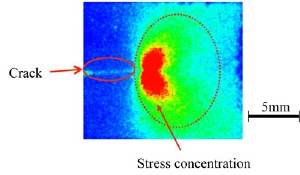Jan 7 2009
Chao-Nan XU, the Advanced Integrated Sensing Team, Naohiro Ueno, the Adaptronics Technology Team, and their team members, the Measurement Solution Research Center of the National Institute of Advanced Industrial Science and Technology (AIST) have developed a technology for visualizing structures defects/damages and their danger levels, which cannot be seen directly from outside, by using luminous intensity distribution of elastico-luminescent materials.
 Seeing the "invisible" fatigue crack and the stress concentration at the crack tip on a metal plate with elastico-luminescent coating
Seeing the "invisible" fatigue crack and the stress concentration at the crack tip on a metal plate with elastico-luminescent coating
Nondestructive testing techniques using X-rays and ultrarsonic waves are used to detect defects in structures. However, it is very difficult to evaluate the danger levels of defects by those techniques. Although it is necessary to detect abnormalities in stress fields simultaneously of defects in order to ascertain the danger levels of defects, it has to date been difficult to detect defects and their stress fields at the same time.
The visualization technique we have developed is to coat the surfaces of structures with a paint that includes minute particles that emit light as a result of mechanical stimulation (elastico-luminescence). Thus, when the structures are subjected to force or vibration, the stress fields and danger levels of defects are made plainly visible at the same time as making the generation and location of defects, such as cracks that do not appear on the surfaces of structures, visible in real time due to luminecence intensity distribution on surfaces generated by stress. The positions and the danger levels of the cracks are detected simultaneously by using this technology, as invisible fatigue cracks and the undetectable stress concentrations of crack tips are made visual by coating metal plates with a paint that includes elastico-luminescent materials.
These results will be presented at FY 2008 Open Symposium of "Advanced Integrated Sensing Technologies," which is one of the research areas in Core Research for Evolutional Science and Technology (CREST) of the Japan Science and Technology Agency, to be held in Tokyo on November 18, 2008.